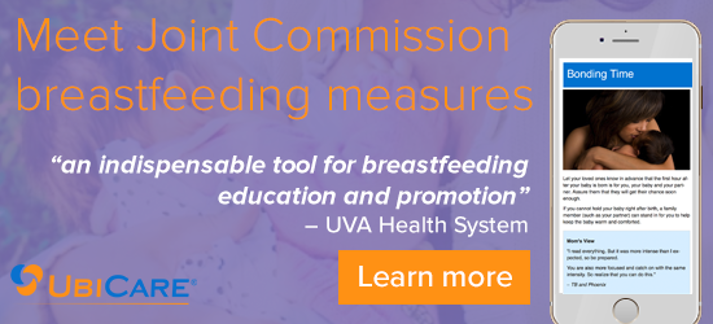
There are many great reasons why hospitals choose to work toward baby-friendly hospital status. There are also plenty of ways to encourage breastfeeding in line with the World Health Organization’s (WHO) guidelines, without having that official Baby-Friendly Hospital title.
Whether or not you’re pursuing baby-friendly status, your hospital can effectively support breastfeeding promotion among staff and patients. Here are 5 ways to go about it:
1. Start educating patients about breastfeeding early.
Setting expectations and goals early in the care process makes it more likely that a patient will achieve desired health objectives. This is true of breastfeeding, as well.
- Educating patients about the benefits of breastfeeding is most successful when it starts during pregnancy. Indeed, Step 3 of WHO’s 10 Steps to Successful Breastfeeding—the key criteria for formal baby-friendly hospital status—requires that hospitals “inform all pregnant women about the benefits and management of breastfeeding.”
- Educating patients proactively, rather than waiting for them to request it, ensures they have the information they need when they need it.
- Educating them digitally means the information can be shared in small, consistent pieces that don’t feel overwhelming to patients. It’s also a time savings for staff and physicians who would otherwise need to use medical appointments for breastfeeding education.
See how UbiCare supports the 10 Steps to Successful Breastfeeding.
2. Weave breastfeeding education into your ongoing staff training.
Keeping your staff updated on supportive breastfeeding practices doesn’t have to be time-consuming or require organized classes. Consider providing digital breastfeeding training and education for staff to access anywhere and at their own convenience. Choose a solution that lets you track their progress, so you know when they’ve read the required information.
3. Stay in touch with patients digitally about breastfeeding support opportunities, even after they’ve returned home.
In the U.S., 81% of infants born in 2013 were breastfed shortly after birth. About 52% were still breastfed by 6 months (with 22.3% exclusively breastfed, as recommended by WHO) and only about 31% were still breastfed at 1 year, according to the CDC’s 2016 Breastfeeding Report Card. A strong connection with your hospital once new mothers are discharged can encourage them to take advantage of available support, overcome challenges and stick with breastfeeding.
Email or text patients who’ve recently delivered to invite them to your breastfeeding support groups or to schedule a session with a lactation consultant. These opportunities provide additional revenue sources, yes, but they encourage continued breastfeeding (with its many health benefits) and nurture relationships with your patients, who will be more likely to return to your hospital in the future—whether for obstetric or other medical care.
4. Ask patients for feedback about your breastfeeding practices.
Breastfeeding is an emotional topic for new mothers. With patient experience and satisfaction so important to a hospital’s bottom line these days, you want to know where you stand in patients’ minds.
Surveys are a great way to measure patient satisfaction with your breastfeeding education practices and policies. Send a quick survey by email or text message, asking patients specifically about how your breastfeeding support has helped them and where you can improve.
5. Collect data on how many patients continue breastfeeding.
Healthy People 2020, the population health measures created by the federal Office of Disease Prevention and Health Promotion, set goals for how many infants are breastfed by the year 2020, including 34% of infants breastfeed at 1 year and 26% breastfed exclusively through 6 months.
If you want to work toward or even surpass this goal, you need to measure how your patients are doing after they leave the hospital. Digital breastfeeding education combined with data collection technology can help you gain insight.
Baby-Friendly status remains the gold standard for many hospitals encouraging breastfeeding. But if you choose not to make the commitment right now, these 5 objectives can help your hospital support and encourage breastfeeding without the formal baby-friendly designation.








